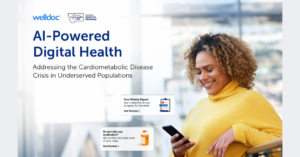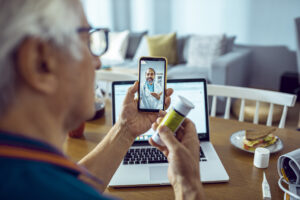Dr. Monique Tello, internal medicine physician, and Dr. Mansur Shomali, Chief Medical Officer at Welldoc®, discuss the complicated questions around CGM and how the real possibilities of CGM lie within digital health.
Dr. Shomali: The CGM device is measuring the glucose in the fluid under the skin, so there’s no catheter that’s actually poking into a blood vessel measuring blood glucose. We call that interstitial fluid glucose…the glucose levels that are in the bloodstream.
Everybody’s got a cell phone. Everybody uses apps. The availability of the best CGM we’ve ever had, along with the explosion of [digital health] tools, such as those that we’re building at Welldoc, has really made a great addition to our way of managing diabetes today.
Dr. Tello: For a lot of my patients who had CGM, it provided that missing link that allowed them to make the connection between what they ate, what they did, and their blood sugar, as well as how they felt at that moment. It took out all the guesswork.
These are really a spectrum of conditions that cluster together. And the treatment for all of them is healthy behaviors, improving activity, making better food choices – they are all linked and related. You can’t take care of a patient with diabetes without addressing their blood pressure, their cholesterol, and their cardiovascular risk. So in order to address the whole patient, we have to take care of the entire cardiometabolic spectrum.
Dr. Tello: Diabetes is a huge, very important medical problem, but as you mentioned, so many people have more than diabetes. It’s part of a larger spectrum of health conditions that are all interrelated.
Interested in learning more about CGM, its potential and its connection to digital health solutions for chronic conditions? Listen to Dr. Shomali and Dr. Tello’s full conversation in our latest podcast here.
What is a continuous glucose monitor?
Dr. Tello: It’s a small wearable device that measures glucose, directly transmitting the numbers to a smartphone app or a monitor about every five minutes without the need for finger sticks.Dr. Shomali: The CGM device is measuring the glucose in the fluid under the skin, so there’s no catheter that’s actually poking into a blood vessel measuring blood glucose. We call that interstitial fluid glucose…the glucose levels that are in the bloodstream.
How has CGM changed diabetes care?
Dr. Shomali: Often people with diabetes may visit a healthcare provider every three months and get a blood test called the A1C test, which gives an average of how they’re doing overall with their diabetes. Some patients are using a blood glucose meter and testing their glucose once a day, or maybe four times a day. Doctors can look at that [CGM] data and help adjust treatment plans based on whether the glucose readings are high, low, or fluctuating. CGM data is revolutionary in that it provides thousands of data points in between [office] visits. It’s a rich set of data that can really help in decision making.Where is CGM technology going?
Dr. Shomali: CGM has never been as accurate or as easy to use as it is today. The sensors that are available are straightforward to apply, less expensive, covered by insurance plans, and more reliable than they’ve ever been. We also have a second important factor, which is the digital revolution that we’re in.Everybody’s got a cell phone. Everybody uses apps. The availability of the best CGM we’ve ever had, along with the explosion of [digital health] tools, such as those that we’re building at Welldoc, has really made a great addition to our way of managing diabetes today.
How have you seen CGM help a patient?
Dr. Shomali: I’ve had patients for whom I’ve tried every medication, insulin, diet, exercise, frequent doctor visits, and not until they started using a CGM were they able to get their glucose levels under control. Patients love CGM. They love the fact that they can know what their glucose levels are at any time of the day without having to do a finger stick, and they love the fact that it helps them stay honest and make good decisions.Dr. Tello: For a lot of my patients who had CGM, it provided that missing link that allowed them to make the connection between what they ate, what they did, and their blood sugar, as well as how they felt at that moment. It took out all the guesswork.
What impact can CGM have on the population level?
Dr. Shomali: Not only do CGM devices help people with diabetes better manage their glucose levels throughout the day, but they provide data to the healthcare team. The doctors, nurses, and educators who help people with diabetes can actually make better adjustments to the medications and the treatments that patients are receiving. CGM is a tremendously valuable tool for healthcare teams. Also, people who use CGM end up having better glucose results over time, so it actually results in fewer complications of diabetes and therefore it’s expected that their healthcare costs would be reduced.What would data-driven insights through CGM look like to the patient?
Dr. Shomali: I’m really proud of the system that we’ve built at Welldoc, where an app that resides on an individual smartphone is monitoring CGM data giving insights that help people make better decisions -and better choices for food, exercise and medication management. In addition, the Welldoc App also helps problem-solve. So at the end of a day, the data comes in and tells the patient, “Hey, here’s how you did yesterday. Here’s what you did well, and here’s what you could do better. Try this moving forward.Has digital health revolutionized the care of chronic conditions other than diabetes?
Dr. Shomali: It seems as though there’s a cardiometabolic spectrum that’s an epidemic in our society right now. We’re talking about hypertension, obesity, diabetes, high cholesterol, heart disease, and heart failure.These are really a spectrum of conditions that cluster together. And the treatment for all of them is healthy behaviors, improving activity, making better food choices – they are all linked and related. You can’t take care of a patient with diabetes without addressing their blood pressure, their cholesterol, and their cardiovascular risk. So in order to address the whole patient, we have to take care of the entire cardiometabolic spectrum.
Dr. Tello: Diabetes is a huge, very important medical problem, but as you mentioned, so many people have more than diabetes. It’s part of a larger spectrum of health conditions that are all interrelated.
How does Welldoc address caring for the whole patient?
Dr. Shomali: The Welldoc App was designed to help people more easily self-manage their medical conditions, like diabetes. It also connects people using the app with their care teams, because people don’t manage their conditions in a vacuum, right? They need to be connected to their doctors, nurses, physician assistants, and everyone who’s involved.Interested in learning more about CGM, its potential and its connection to digital health solutions for chronic conditions? Listen to Dr. Shomali and Dr. Tello’s full conversation in our latest podcast here.




